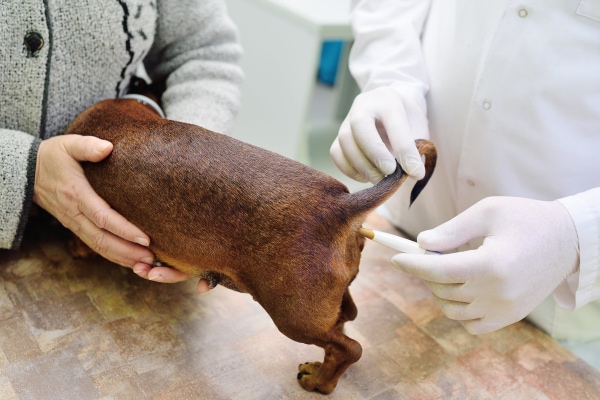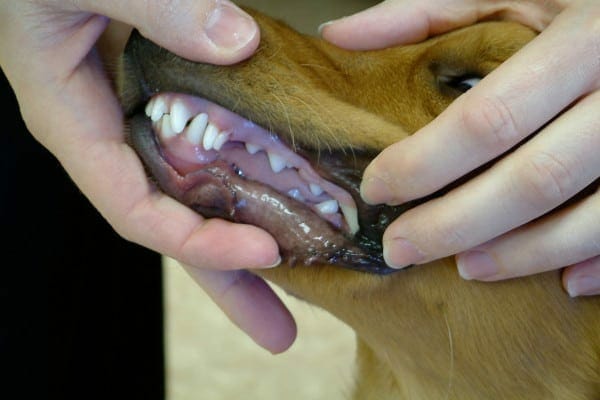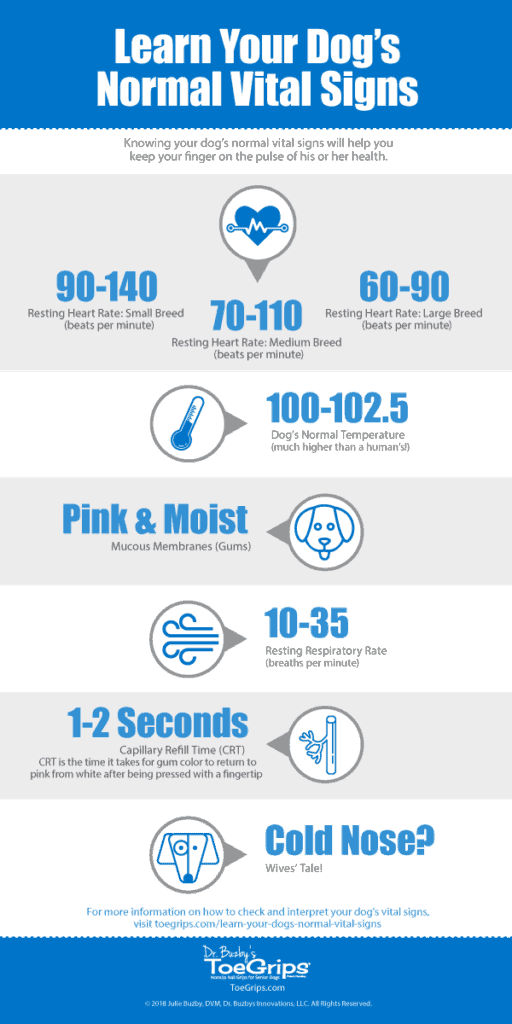Do you know how to assess your dog’s vital signs at home? Capturing a baseline of your dog’s normal heart rate, body temperature, gum color, respiratory rate, and capillary refill time just may help you save your dog’s life someday. By the end of this article, you’ll have a clear understanding of normal dog vital signs, the five parameters of dog vitals, and how to assess each one. Integrative veterinarian Dr. Julie Buzby is here to help you keep a “pulse” on your dog’s health.

With the increased popularity of smart watches and other fitness trackers, many of us (myself included!) are more aware than ever of our own vital signs. But did you know that your dog’s vital signs can give you just as much information as your own?
Dog vitals include heart rate, body temperature, mucous membrane (gum) color, respiratory rate, and capillary refill time (CRT). These pieces of your dog’s health puzzle can provide important information on his or her overall health. Being familiar with what normal vitals are can help you know when something is off.
Vital Sign #1: Know the normal heart rate for a dog at rest
Let’s start by assessing a key dog vital sign: your dog’s heart rate. The term “heart rate” literally means how fast the heart itself is beating. It is measured by counting the number of times the heart beats in a minute.
Normal dog pulse ranges differ based on size/breed. Although individual variation occurs, normal heart rate for dogs at rest are typically:
- Small breed: 90 – 140 beats per minute
- Medium breed: 70 – 110 beats per minute
- Large breed: 60 – 90 beats per minute

How to take your dog’s heart rate
Before you check your dog’s heart rate at home, make sure that your dog has not been active, excited, or stressed. A dog’s resting heart rate should be established when he or she is—you guessed it—at rest. The pulse of a dog who has been exercising or excited will be higher. It’s important to capture your dog’s baseline.
Here’s how to find your dog’s resting heart rate :
1. Identify anatomic landmarks.
Once your dog is relaxed and calm, the best place to find your dog’s heart rate is the left side of the chest, right behind the dog’s elbow. If you’re looking at the dog, look from the left side and you’ll see the dog’s elbow.
2. Place your palm on your dog’s chest wall.
If you have a stethoscope, you can use it to count the beats. Otherwise, put the flat palm of your hand on your dog’s chest wall. You should be able to feel the heart beating. If your dog prefers to lie down, have him or her lie on the right side. Then take the forelimb and flex the elbow back—where it touches the chest wall is a good guideline.
3. Count the number of beats.
The easiest way to gather your dog’s heart rate is to count the number of beats per 15 seconds and then multiply by four. Of course, you can count beats for 30 seconds and multiply by two, but your dog may not appreciate sitting still for that long!
What to do if your dog’s heart rate doesn’t seem normal
Remember that the ranges for dog pulse rates given above are general guidelines. If your dog’s resting heart rate falls outside of the expected range, don’t panic!
All vitals should be evaluated in context. If your dog otherwise appears healthy, is breathing normally, etc., a faster or slower resting heart rate may be normal for him or her. The other thing to keep in mind is that checking vital signs is just a snapshot of a moment in time. Just because that is your dog’s pulse at that moment doesn’t necessarily mean that it’s that rate all the time. If you’re concerned that what you’ve measured is outside the range of normal vital signs for dogs, wait a bit and check again.
Vital Sign #2: Learn the normal body temperature for dogs
Body temperature is another important vital sign in dogs. What is considered a normal body temperature for a dog? Interestingly, it is higher than that of humans, which we know is 98.6ºF.
A normal body temperature for a dog ranges between 100º – 102.5ºF. It is important to note that a dog who has been exercising will have a higher body temperature—possibly even 103ºF. We do want to keep in mind, however, that high body temperatures can be associated with heatstroke in dogs.

How to take your dog’s temperature
1. Make sure your dog is calm and happy.
Choose a time when your dog is happy, healthy, and has not been vigorously exercising. You should also be in an area with a comfortable temperature. Taking a dog’s temperature outside on a hot, sunny day will not give the same result as in an air-conditioned room, even if the dog is completely healthy.
2. Gather your tools.
Before you begin, make sure you have a standard digital thermometer, a water-soluble lubricant such as KYJelly, and a friend or family member to help distract your dog and help hold him or her still.
3. Use the lubricated thermometer to check a rectal temperature.
While your helper distracts your dog, gently lift up the dog’s tail. Carefully insert the tip of the lubricated thermometer into your dog’s rectum.
Leave the thermometer in place for about a minute or until it beeps.
Gently remove the thermometer to read the results. This will be your dog’s baseline temperature. Also, be sure to give your dog plenty of head rubs and praise for a job well done!
Another option…
Although typically less accurate than a rectal temperature, ear thermometers can also be used on dogs. Using an ear thermometer is less invasive and may be better tolerated by some dogs. Just make sure to use a different ear cone cover than you do for your human family members!
If your dog’s temperature falls outside of the normal range of 99º-103ºF, try rechecking it after a bit. If it’s still consistently outside that range and/or your dog is showing other signs of illness, call your vet for guidance.
Vital sign #3: Assess the color of your dog’s gums (mucous membranes)
What color should your dog’s gums be? The mucous membranes (your dog’s gums) should be pink and moist. I would encourage you to get in the habit of gently lifting your dog’s upper lip to check the color of your dog’s gums. Many dogs have dark spots on the gums, which can be normal pigmentation. Some breeds, such as Chow Chows, have completely pigmented/black gums. By frequently looking at your dog’s mouth, you’ll have a visual roadmap of what your dog’s normal gums look like. Any color of white, grey, purple, or dark red is significant—a sign of a veterinary emergency.


All vital signs should be evaluated in context. If your dog seems lethargic, ataxic (wobbly gait), or is otherwise acting off, checking mucous membrane color is a good place to start. If you notice a change in your dog’s normal gum color, especially if they appear pale or white, seek veterinary care right away!
Pale gums can be a sign of internal bleeding. Dark red gums can be seen with shock, heat stroke, and other conditions. It’s generally a good idea to check your dog’s other vital signs if you suspect mucous membrane color is off.
Vital sign #4: Know the normal respiratory rate in dogs
Next, your dog’s respiratory rate is another important vital sign. Respiratory rate in dogs is measured by the number of breaths per minute. A dog’s normal respiratory rate at rest is 10 to 35 breaths per minute.
How to measure your dog’s respiratory rate
- Choose a time when your dog is relaxed, healthy, and has not been exercising.
- While your dog is resting, watch for the rise and fall of his or her chest. Each corresponding rise and fall counts as one breath.
- As an alternate method, you can put your hand gently in front of your dog’s nostrils and feel the air pushing out with each exhale.
- Count the number of breaths per 30 seconds and then multiply by two. This is your dog’s baseline respiratory rate.

Keep in mind that dogs pant when they’re excited or have been exercising, and that sniffing can affect respiratory rates. When checking respiratory rates at home in healthy dogs, I suggest looking at the patterns. If your dog normally has a respiratory rate of 12 at rest, and suddenly it isn’t going below 40, something may be up.
Vital sign #5: Checking capillary refill time (CRT) in dogs
Checking your dog’s capillary refill time is the fifth parameter of learning dog vital signs. Capillaries are the tiny blood vessels that provide blood to tissues all over the body. The capillaries in your dog’s mucous membranes can give information about their circulatory health. When you press against the gum tissue and then release, you’ve pushed the blood out of the capillaries causing the gum to appear white. As the capillaries refill with blood, the gums return to pink.
Capillary refill time (CRT) is the time it takes for a dog’s gum color to return from white to pink after being pressed with a fingertip. It’s an important tool in assessing your dog’s normal vital signs.
How to check your dog’s capillary refill time
While you’re assessing the color of your dog’s gums, take a moment to check your dog’s capillary refill time. Firmly press against your dog’s gum tissue with your fingertip and then quickly release. Watch how long it takes for the gum to turn back to pink from white. One to two seconds is considered a normal CRT.
As an aside, if you’re manipulating your dog’s mouth to check vital signs, make sure to do so safely! Some dogs are not always tolerant of their mouths being touched, and we don’t want anyone getting bitten! If your dog won’t tolerate his or her mouth being touched, talk to your vet about other ways to monitor your pup’s health.
Dog vital signs chart
I hope you now feel empowered to check your dog’s vital signs and keep an eye on deviations from normal. Below is a dog vital signs chart to remind you what “normal” looks like. Again, remember that individual variation exists, and this is only meant as a general guideline. Discuss any concerns about your dog’s vital signs with your veterinarian.

Bonus: Dispelling the cold nose myth
Here’s a bonus tip for you: A dog’s cold nose is not an accurate way to assess your dog’s health. Not only can your dog’s nose be a variety of temperatures and moistness levels, but it also may vary throughout the day. The only thing a cold, wet nose tells me is that the dog has recently licked their nose.

Learn your dog’s vital signs
You know your dog better than anyone else. By taking the time to establish a healthy baseline for your canine companion’s heart rate, body temperature, respiratory rate, mucous membrane color, and CRT, you’re ensuring your dog has the healthiest life possible. If your dog is ever sick or injured, you can communicate to your veterinarian how your dog’s vital signs have changed—and help ensure the best outcome possible for your loyal companion.
What questions do you have about checking your dog’s vital signs?
We’d love to hear. Please comment below.


this was very helpful for me and my furry bestie I only have one question. He’s an American strat frier terrier and I keep hearing different thoughts on what is considered old for them, he’s a little over 5 pushing 6 I believe is he just an adult or is that old? And do you know of any common age related issues I might shld watch for like brain tumors for instance, and would something if that nature change vitals if so in what way would the diff from the norm?
Hi Nibz & Mom,
When trying to figure out when a dog moves into the senior stage, I like to refer to a wonderful chart found on the Pet Health Network website. It is based on body weight and age. Here is a link to the chart: https://www.pethealthnetwork.com/dog-health/dog-checkups-preventive-care/how-old-your-dog-people-years
I looked up this specific breed in my reference that details breed specific predispositions to diseases. What is listed for American Staffordshire Terriers is skin issues such as allergies and masses/lumps/bumps, hypothyroidism, and knee issues/cruciate ligament injuries. Is there any specific reason you are concerned about brain tumors? Just wondering if your boy is exhibiting any new symptoms or issues that are concerning. There are too many possibilities of how different diseases can change vital signs to list them all. The best advice I can give is to know what is normal for your pup. That way when you notice something abnormal, you can call your vet right away and get your boy evaluated. It isn’t so important for you to be able to diagnose the cause of a problem, as it is imperative you recognize when there is a problem so you can give your vet the opportunity to find the cause quickly and start treatment. Hope this helps a bit. Best wishes to you and your sweet boy!
Hi, Can you please recommend an ear thermometer for my lab? It’s hard to know what the best one is. Thank you! Betsy
Hi Betsy,
I do not have much knowledge on the different ear thermometer options as I don’t routinely use these in practice. I always use a rectal thermometer and find them to be more accurate. I do think it would be helpful to have one with a soft/flexible tip to the ear cone since you may not be able to have your pup hold completely still while taking their temperature.
Always informative but when I try to print this out, I find the top part of the page is blocked by the Toe Grips promotion. Any suggestions about getting a clean copy? Thanks.
-from Not the Greatest Internet manipulator
Hi Mary,
You can try highlighting the text you are interested in with the cursor. Once the words are highlighted, you can right click and select copy. You should be able to open a blank Word document then right click and select paste. The text you highlighted should appear on the Word document and print easily from there. I hope this helps!
I’m always looking for concise, accurate information on how to be a better pet parent to my dog. This is exactly what I need, and helps me feel more aware of when my dog may be suffering in any way. Thank you so very much! I always look forward to reading all your articles and posts, and value them all.
Deborah,
Thank you very much for your kind words! We are so happy that our blog posts are helpful to you and your dog because this means we are accomplishing our goal.❤
I want to thank you for this article, with the help of this blog I got a lot of information about vital signs. Keep giving us this information.
Hello Karan, you are very welcome. I’m delighted to know it was helpful to you! Thank you for being a Buzby Bark reader. ♥️